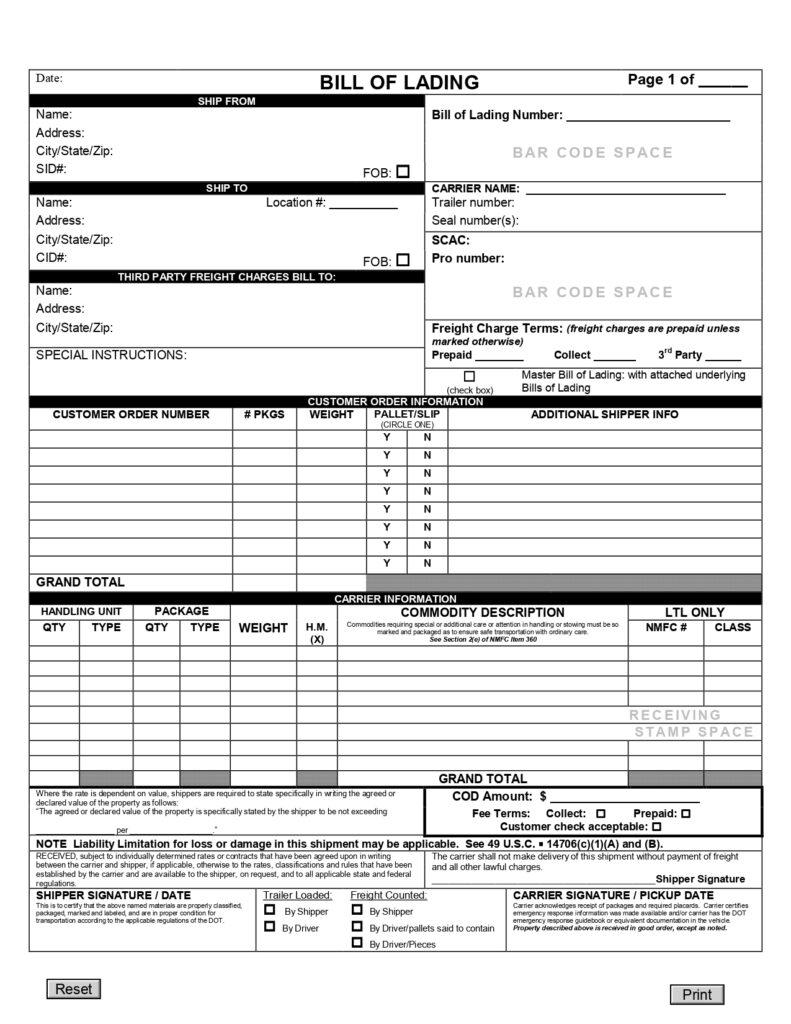A bill of lading or just a BoL is a legal document. It describes the details about the type, quantity and destination of the goods. A carrier issues this document to the shipper while they ship certain type of products.

The BoLs usually serve as a type of shipment receipts too. The carrier, shipper, and receiver’s signature are necessary to consider the BoL or bill of lading valid.
There are multiple versions or types of Bill of Lading documents. You can come across a negotiable or a non negotiable bill of lading types, for example.
Read more in this blog post to learn about the meaning of the bill of ladings. This article will help you to learn more about the tips you can use to make the shipment of your traded goods smoother.
The more you know about your rights in eCommerce and the shipping documentation, the more you can make your business manageable. So let’s dig into this right from the beginning.
What is a Bill of Lading?
As already mentioned, the bill of lading is a legal document. It’s a well-known document for anyone involved in shipping or logistics. These documents are essential as they serve as proof of shipment. As long as the sellers take care of inventory shrinkage or theft, the BoLs will be helpful.
Initially, no matter the types of lading documents, they serve three purposes. Firstly they inform about the type of products about to ship. Secondly, they are receipts. This is to say you can make comparisons based on the Bols when you receive the products to your initial Purchase order.
And finally, the Bols help to agree with the shipper and the carrier. The latter refers to the mutually agreed terms and conditions of the transportation of goods.
Besides the main goal to prevent inventory theft, the bill of lading prevents frauds as well. It’s also a type of document you can use to gain better internal control of your business.
Take a look at a sample example of this document.

It typically includes the bill of lading number, names and addresses of the shippers and receivers. You can also see the shipment date, quantity, exact weight, value, and freight classification. Typically the BoL blank informs whether the product is hazardous or not and the specific instructions to the carrier if needed.
You can find information also about the NMFC freight classes as well. It’s not big news that the freight classes have a huge impact on the shipment cost. Based on 18 different classes the shipping cost varies. It depends on the weight, dimensions, value, liability and many other factors.
Types of Bill of Lading
There are different types of BoL documents. Therefore we will discuss each class depending based on their executions. They may vary depending on various factors. It may start from the form of transmission and end up with the purpose of it.
Let’s cover each type one by one and understand their purpose in the shipment of the goods.
Negotiable vs Non-Negotiable BoL
The Negotiable BoL as a legal document is also a type of contract that gives the right to transfer a carriage to a third party. In the case of a Negotiatale BoL, there are specific, clear instructions. This is to say that the delivery of the goods is provided to those who have the original copy of the bill. The key point to understand the negotiable Bols or NBLs is that they can be issued to a third party by way of consignment.
The process of BoL processing is easy to understand. Firstly the buyer or the consignee signs the document, thus endorses it to deliver to a consignee or a third party. Therefore the carriers should deliver the goods to the final destination where a new Negotiable Bill of Lading should be issued. The latter comes back to the order of the consignee.
As for the A non-negotiable BoL, there is only one specific consignee. It doesn’t represent the ownership of products; therefore, it’s usually accompanied by other documents.
In the case of the negotiable, the original copy should be presented at the discharge port; otherwise, the freight won’t be released.
Straight Bill of Lading
This is a type of non-negotiable Bill of lading. This type of delivery refers to cases when everything is already paid. The donations or gifts can be sent under the straight Bill of ladings too.
This type, however, has its benefits and pitfalls. It suits best the exporters and importers who value the transit time reduction the most. Usually, they have established relationships and trust, so the payment is not an issue.
Therefore there might be cases when straight BoLs can be risky. It’s mainly because there is no need to represent it both by the buyer and the receiver to get the goods. The problem refers primarily to the issuing banks who can go through fraud risks.
Open Bill of Lading
In this type of BoL, it’s normal to change the name of the consignee to the consignees’ signature. The process can be transferred multiply. This is to say the process can go till the last holder. Therefore this is also a negotiable document.
Bearer Bill of Lading
As the name itself says, the delivery should be made to the holder of the Bill. This document intends to serve the resale products. Logically it’s a negotiable document. This is another type of risky document as in case of a loss of stock, the tracing of the snap won’t be easy. The cargoes who sell in bulks prefer bearer BoLs, as they later intend to turn over in small quantities.
eSwap-Shipping Management
As long as you take care of the right legal shipping procedure, it would help to make things easier for your shipping management. eSwap is here to help you with that. We can help you with your multi-channel orders management with our Shipping Management software feature. We, as advanced software for e-commerce retail, offer you integrations with famous shipping couriers like UPS, USPS, FedEx, and DPD.
You, as an eCommerce retailer, can make shipping rate comparisons and make the right choice among them for your business. After that, you can integrate it into your shop and start your product shipping journey. And all of that is possible to arrange right from here, all from one dashboard!







